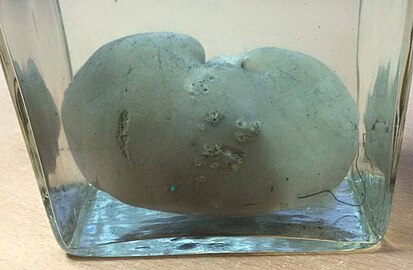
Abscess
An abscess is a collection of pus that has built up within the tissue of the body.[1] Signs and symptoms of abscesses include redness, pain, warmth, and swelling.[1] The swelling may feel fluid-filled when pressed.[1] The area of redness often extends beyond the swelling.[6] Carbuncles and boils are types of abscess that often involve hair follicles, with carbuncles being larger.[7] A cyst is related to an abscess, but it contains a material other than pus, and a cyst has a clearly defined wall.
This article is about the medical condition. For the death metal band, see Abscess (band).
They are usually caused by a bacterial infection.[8] Often many different types of bacteria are involved in a single infection.[6] In many areas of the world, the most common bacteria present is methicillin-resistant Staphylococcus aureus.[1] Rarely, parasites can cause abscesses; this is more common in the developing world.[3] Diagnosis of a skin abscess is usually made based on what it looks like and is confirmed by cutting it open.[1] Ultrasound imaging may be useful in cases in which the diagnosis is not clear.[1] In abscesses around the anus, computer tomography (CT) may be important to look for deeper infection.[3]
Standard treatment for most skin or soft tissue abscesses is cutting it open and drainage.[4] There appears to be some benefit from also using antibiotics.[9] A small amount of evidence supports not packing the cavity that remains with gauze after drainage.[1] Closing this cavity right after draining it rather than leaving it open may speed healing without increasing the risk of the abscess returning.[10] Sucking out the pus with a needle is often not sufficient.[1]
Skin abscesses are common and have become more common in recent years.[1] Risk factors include intravenous drug use, with rates reported as high as 65% among users.[2] In 2005, 3.2 million people went to American emergency departments for abscesses.[5] In Australia, around 13,000 people were hospitalized in 2008 with the condition.[11]
An abscess is a defensive reaction of the tissue to prevent the spread of infectious materials to other parts of the body.[22][23]
Organisms or foreign materials destroy the local cells, which results in the release of cytokines. The cytokines trigger an inflammatory response, which draws large numbers of white blood cells to the area and increases the regional blood flow.[23]
The final structure of the abscess is an abscess wall, or capsule, that is formed by the adjacent healthy cells in an attempt to keep the pus from infecting neighboring structures. However, such encapsulation tends to prevent immune cells from attacking bacteria in the pus, or from reaching the causative organism or foreign object.[23]
Prognosis[edit]
Even without treatment, skin abscesses rarely result in death, as they will naturally break through the skin.[3] Other types of abscess are more dangerous. Brain abscesses may be fatal if untreated. When treated, the mortality rate reduces to 5–10%, but is higher if the abscess ruptures.[34]
Epidemiology[edit]
Skin abscesses are common and have become more common in recent years.[1] Risk factors include intravenous drug use, with rates reported as high as 65% among users.[2] In 2005, in the United States 3.2 million people went to the emergency department for an abscess.[5] In Australia around 13,000 people were hospitalized in 2008 for the disease.[11]

